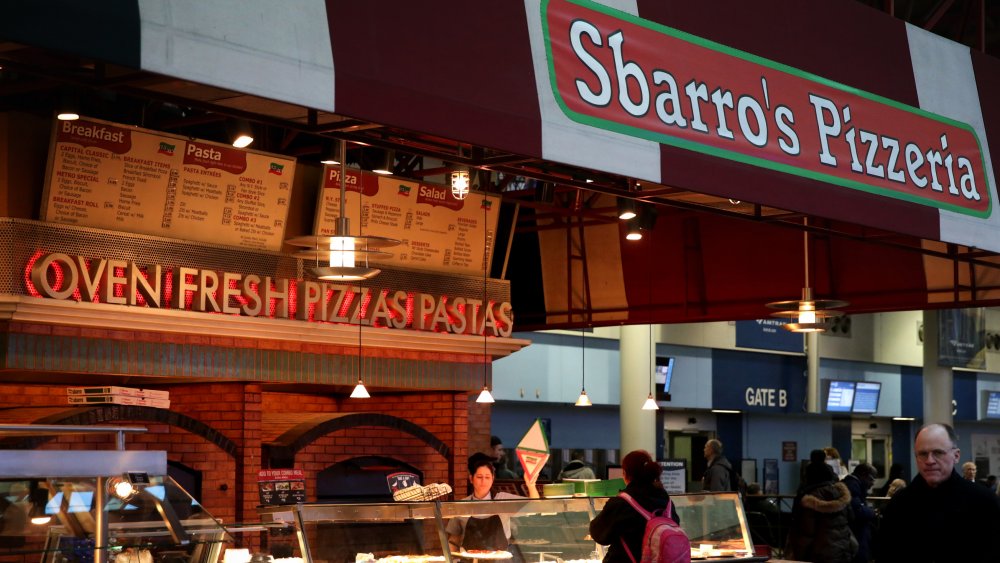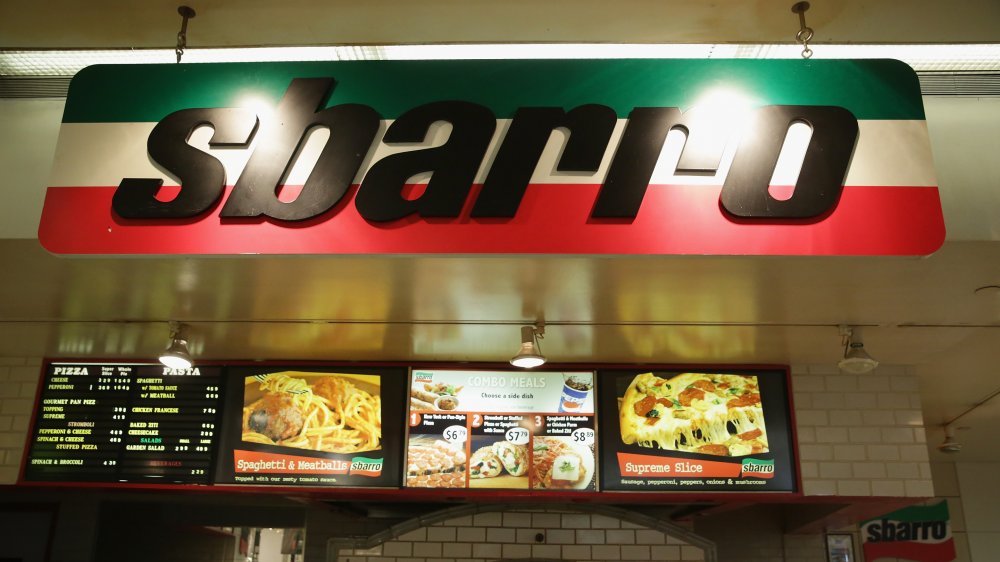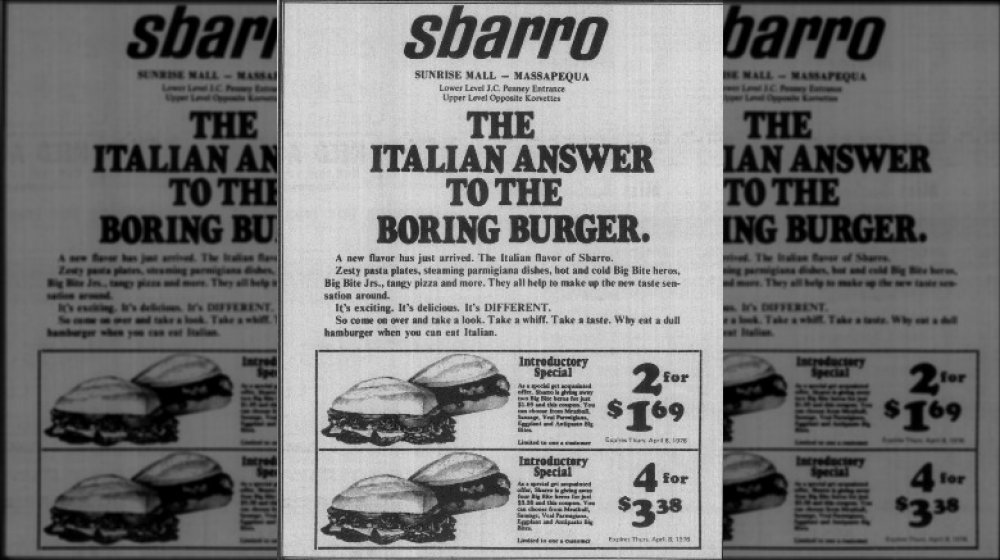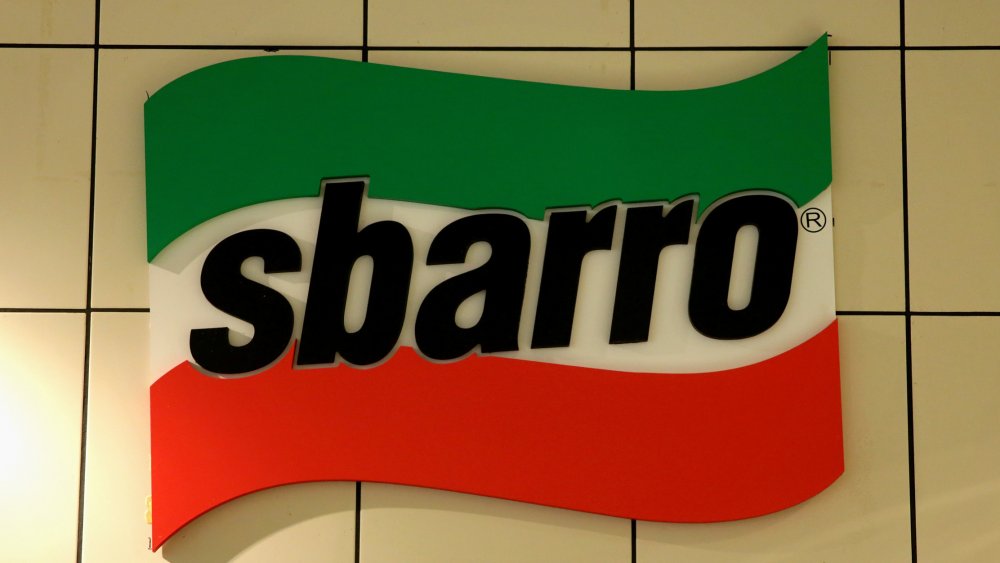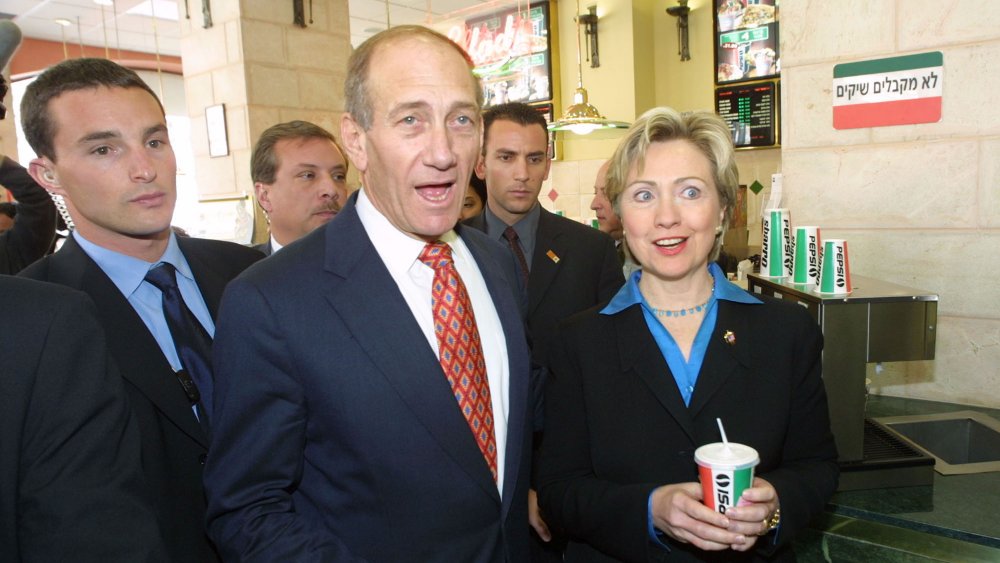The Untold Truth Of Sbarro
Like many good Italian kitchens, there's a headstrong, never-put-mayonnaise-on-your-prosciutto-sandwich woman behind Sbarro. Carmela "Mama" Sbarro grew up in Mussolini's Italy. Before she turned 10 years old, she'd started gaining the skills that would define her life, working at a butcher shop in Naples. The petite woman, who served her customers insatiably from 9 am to 8 pm daily while wearing high heels and impeccable makeup, immigrated with her husband and three sons to Brooklyn in 1956 (via Gothamist, Nation's Restaurant News, and The New York Times). She was 35 years old.
By 1957, the family had opened their first restaurant in Bensonhurst, Brooklyn, thanks in part to money Carmela Sbarro had saved sewing dolls' clothes. By the time the Sbarro family was successful enough to open up restaurants across New York, Mama Sbarro was personally supervising the preparation of between 1,500 and 2,000 cheesecakes per week. The formidable Sbarro matriarch refused to stop working until 2004, at the age of 83. When she retired and Sbarro closed down its original Bensonhurst deli, the restaurant chain had reached the height of its success. That year, 762 locations netted $465 million in systemwide sales (via Eater).
The alleged connections between Sbarro and the Mafia
It sounds like a movie for Robert De Niro, but it's true. There's a dark side to New York's Italian pizza. It goes back to the years between 1976 and 1984. Between those years, undercover FBI agent Joe Pistone documented the Sicilian Mafia's and Bonanno crime family's use of pizza parlors to import $1.6 billion worth of contraband drugs (via the FBI). Sbarro was not implicated in that scandal. However, in 1980, it was implicated in Genovese mob kingpin's Frank "Funzi" Tieri's trial. While Sbarro was never charged, Prosecutors claimed Tieri had been using Sbarro — a restaurant they claimed Tieri had previously owned — to launder money (via Gannett Westchester Newspapers).
Nor was Sbarro implicated in 2012, when Bronx pizzeria owner and possible Genovese crime family associate "Johnny Pizza" Porcello was arrested for criminal racketeering (via Vice). But Sbarro didn't escape from 2012 entirely unscathed. That same year, The New York Daily News claimed to be in possession of documents obtained through the Freedom of Information Act. These supposedly connected the Jewish mobster, Julius Bernstein, to the Sbarro restaurant chain. If the newspaper's reports are true, Bernstein told the FBI that the Genovese crime family had been "shaking down" Sbarro since the 1960s and that at some point he was tasked with collecting the dough. By 2004, Sbarro may have been paying $20,000 to Bernstein in the form of yearly "protection" payoffs.
Truth or fiction? We may never know.
Sbarro didn't always think of itself as a pizza place
Sbarro didn't always dream of being known for its pizza. In 1957, the Sbarro family opened the delicatessen that Mama Sbarro would run with an iron hand until it closed in 2004. The Bensonhurst deli had meats and cheeses hanging from the ceiling and served up plates of chicken parmigiana, smoked mozzarella, and prosciutto sandwiches (via The New York Times). It introduced pizza-by-the-slice to cater to its working-class customers, looking for quick meals between shifts (via Eater).
By the 1960s, Sbarro opened a second Bensonhurst location dedicated to Pizza. But when its first mall locations opened in the 1970s, it took advantage of growing consumer demand for quick food and served up a broad range of culinary offerings (via Eater). In the early 70s, the restaurant advertised itself as "New York's leading home caterer of quality Italian food" highlighting its lasagna and stuffed eggplant (via Fulton History). By the mid-1970s, an ad proclaimed that Sbarro was the "The Italian Answer to the Boring Burger" (via New York State Historic Newspapers). Could you order a slice of pizza at a 70s Sbarro? Sure. But you could just as easily get yourself pasta plates, parmigiana dishes, and "hot and cold Big Bite heroes."
In fact, Sbarro didn't let go of its varied menu until the 1990s. Only then did it narrow down its menu to the pizzas, salads, and breadsticks that we know it for today (via Eater).
Sbarro has come back from the dead twice
Today, Mama Sbarro's legacy lives on in the form of 630 Sbarro stores in 28 countries across the globe (via Sbarro). It's a far cry short of the company's 762 locations in 2004. On the other hand, the company isn't on the brink of ruin as it has been twice in the past decade.
In 2011, the company filed and clawed its way out of bankruptcy. It did so after closing down 25 restaurants, shaking off $200 million in debt, and introducing open-flame ovens, made-to-order pizza stations, and all-natural ingredients (via QSR). In 2014, the company filed for bankruptcy again in an attempt to cut its debt by 80 percent, citing fewer customers at their mall locations and an outdated business model that depended on customers wanting to buy "food that has been sitting out for a while" (via Reuters). Miraculously, the company emerged from this bankruptcy as well.
And while Sbarro locations may be slowly disappearing across the United States, they're still opening across the globe. In 2017, Sbarro expanded to Uruguay and Romania (via Sbarro and Restaurant Development + Design). In 2018, it announced a plan to open 300 restaurants in Russia by 2027 (via Reuters). And in 2019, Sbarro opened its first restaurant in Costa Rica (via QSR). Whatever you personally think about the quality of their food, Sbarro is far from throwing in the towel.
The tragic entanglements of Sbarro with international terrorism
On September 11th, 2001, Sbarro tragically lost one of its pizza makers and two World Trade Center locations in the terrorist attacks that took nearly 3,000 lives (via Wine Spectator and History). In 9/11's aftermath, the restaurant chain reported significant losses in sales as it was forced to temporarily close dozens of franchise and company-owned sites at airports (via Pizza Marketplace).
9/11 was the second time in less than two months that Sbarro locations had been hit by terrorist attacks. In August of that year, the pizzeria unwittingly became the center of a decades-long and seemingly unsolvable political conflict that continues to shape the world today. On August 9, a Palestinian suicide bomber smuggled a bomb hidden in a guitar case into a crowded Sbarro in Jerusalem and detonated it, killing himself and taking the lives of 15 other victims (via The Jerusalem Post). The attack was part of coordinated Palestinian uprisings related to territory disputes. Beginning in 2000, an increasing number of Palestinian riots, bus bombings, and terrorist attacks against Israelis had been met with escalated Israeli military assaults and killings of Palestinians (via Vox). The "Sbarro Massacre" turned the international media's attention to the everyday violence lived by Israelis and Palestinians as a result of the conflict. It garnered so much media coverage that then-senator Hillary Rodham Clinton visited the pizzeria on her February 2002 visit to Israel, pointing to Sbarro as an emblem of Jerusalem's resilience (via UPI).
